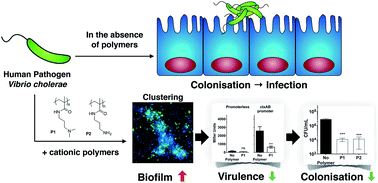当前位置:
X-MOL 学术
›
Chem. Sci.
›
论文详情
Our official English website, www.x-mol.net, welcomes your
feedback! (Note: you will need to create a separate account there.)
Engineering microbial physiology with synthetic polymers: cationic polymers induce biofilm formation in Vibrio cholerae and downregulate the expression of virulence genes
Chemical Science ( IF 7.6 ) Pub Date : 2017-05-16 00:00:00 , DOI: 10.1039/c7sc00615b Nicolas Perez-Soto 1, 2, 3, 4, 5 , Lauren Moule 1, 2, 3, 4, 5 , Daniel N. Crisan 2, 3, 4, 5, 6 , Ignacio Insua 2, 3, 4, 5, 6 , Leanne M. Taylor-Smith 1, 2, 3, 4, 5 , Kerstin Voelz 1, 2, 3, 4, 5 , Francisco Fernandez-Trillo 2, 3, 4, 5, 6 , Anne Marie Krachler 1, 2, 3, 4, 5
Chemical Science ( IF 7.6 ) Pub Date : 2017-05-16 00:00:00 , DOI: 10.1039/c7sc00615b Nicolas Perez-Soto 1, 2, 3, 4, 5 , Lauren Moule 1, 2, 3, 4, 5 , Daniel N. Crisan 2, 3, 4, 5, 6 , Ignacio Insua 2, 3, 4, 5, 6 , Leanne M. Taylor-Smith 1, 2, 3, 4, 5 , Kerstin Voelz 1, 2, 3, 4, 5 , Francisco Fernandez-Trillo 2, 3, 4, 5, 6 , Anne Marie Krachler 1, 2, 3, 4, 5
Affiliation

|
Here we report the first application of non-bactericidal synthetic polymers to modulate the physiology of a bacterial pathogen. Poly(N-[3-(dimethylamino)propyl] methacrylamide) (P1) and poly(N-(3-aminopropyl)methacrylamide) (P2), cationic polymers that bind to the surface of V. cholerae, the infectious agent causing cholera disease, can sequester the pathogen into clusters. Upon clustering, V. cholerae transitions to a sessile lifestyle, characterised by increased biofilm production and the repression of key virulence factors such as the cholera toxin (CTX). Moreover, clustering the pathogen results in the minimisation of adherence and toxicity to intestinal epithelial cells. Our results suggest that the reduction in toxicity is associated with the reduction to the number of free bacteria, but also the downregulation of toxin production. Finally we demonstrate that these polymers can reduce colonisation of zebrafish larvae upon ingestion of water contaminated with V. cholerae. Overall, our results suggest that the physiology of this pathogen can be modulated without the need to genetically manipulate the microorganism and that this modulation is an off-target effect that results from the intrinsic ability of the pathogen to sense and adapt to its environment. We believe these findings pave the way towards a better understanding of the interactions between pathogenic bacteria and polymeric materials and will underpin the development of novel antimicrobial polymers.
中文翻译:

使用合成聚合物工程化微生物生理学:阳离子聚合物可诱导霍乱弧菌中生物膜的形成并下调毒力基因的表达
在这里,我们报告了非杀菌合成聚合物在调节细菌病原体生理上的首次应用。聚(N- [3-(二甲基氨基)丙基]甲基丙烯酰胺)(P1)和聚(N-(3-氨基丙基)甲基丙烯酰胺)(P2),与霍乱弧菌(引起霍乱的传染源)表面结合的阳离子聚合物疾病,可以将病原体隔离成簇。聚集后,霍乱弧菌过渡到无柄的生活方式,其特征在于生物膜产量增加和关键毒力因子(例如霍乱毒素(CTX))的抑制。此外,聚集病原体导致对肠上皮细胞的粘附和毒性最小化。我们的结果表明,毒性的降低与游离细菌数量的降低有关,而且与毒素产生的下调有关。最后,我们证明了这些聚合物可以减少摄入霍乱弧菌污染的水后减少斑马鱼幼虫的定殖。。总体而言,我们的结果表明,无需进行遗传操作即可对这种病原体的生理进行调节,并且这种调节是一种脱靶效应,它是由病原体感知和适应其环境的内在能力引起的。我们相信这些发现为更好地理解病原细菌与聚合材料之间的相互作用铺平了道路,并将为新型抗微生物聚合物的发展奠定基础。
更新日期:2017-05-31
中文翻译:

使用合成聚合物工程化微生物生理学:阳离子聚合物可诱导霍乱弧菌中生物膜的形成并下调毒力基因的表达
在这里,我们报告了非杀菌合成聚合物在调节细菌病原体生理上的首次应用。聚(N- [3-(二甲基氨基)丙基]甲基丙烯酰胺)(P1)和聚(N-(3-氨基丙基)甲基丙烯酰胺)(P2),与霍乱弧菌(引起霍乱的传染源)表面结合的阳离子聚合物疾病,可以将病原体隔离成簇。聚集后,霍乱弧菌过渡到无柄的生活方式,其特征在于生物膜产量增加和关键毒力因子(例如霍乱毒素(CTX))的抑制。此外,聚集病原体导致对肠上皮细胞的粘附和毒性最小化。我们的结果表明,毒性的降低与游离细菌数量的降低有关,而且与毒素产生的下调有关。最后,我们证明了这些聚合物可以减少摄入霍乱弧菌污染的水后减少斑马鱼幼虫的定殖。。总体而言,我们的结果表明,无需进行遗传操作即可对这种病原体的生理进行调节,并且这种调节是一种脱靶效应,它是由病原体感知和适应其环境的内在能力引起的。我们相信这些发现为更好地理解病原细菌与聚合材料之间的相互作用铺平了道路,并将为新型抗微生物聚合物的发展奠定基础。











































 京公网安备 11010802027423号
京公网安备 11010802027423号